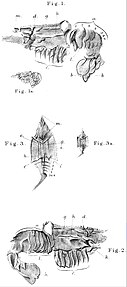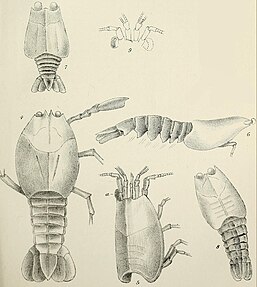|
Tealliocaris
Tealliocaris is an extinct genus of pygocephalomorphans that lived from the Late Devonian to Early Carboniferous periods in Europe and North America. The genus was established in 1908 by Ben Peach, and many species have been assigned to it since, though some are now invalid or have been reassigned to other genera. Although it can be inferred that T. loudonensis was originally intended as the type species of Tealliocaris, this species is now deemed a junior synonym of T. woodwardi, first described as a species of Anthrapalaemon in 1877, and thus T. woodwardi is currently deemed the type species of the genus. Discovery and namingEarliest findsFigures drawn by Etheridge in 1877 (left) and 1879 (right) of T. woodwardi fossils, originally labelled as Anthrapalaemon woodwardi Species of Tealliocaris have been described before the genus was established, originally being placed into the genus Anthrapalaemon. In 1877, British paleontologist Robert Etheridge, Junior became the first to study fossils of Tealliocaris, analysing an iron nodule containing remains of two individuals discovered by James Connie (a collector of the Geological Survey of Scotland) in Carboniferous-aged deposits at Belhaven Bay, near Dunbar, Scotland. Believing they were similar to remains of Anthrapalaemon, he tentatively assigned this specimen as a new species of the genus which he named Anthrapalaemon? woodwardi after English paleontologist Henry Woodward.[1] Later in 1879, Etheridge redescribed the species after studying more specimens of it found by A. Macconochie in three other southern Scottish sites, and confidently designated it as a species of Anthrapalaemon.[2] Two other species were first described as members of Anthrapalaemon in 1882 by British paleontologist Ben Peach under the names A. etheridgii and A. formosa respectively, with the additional erection of a subspecies of the former named A. etheridgii var. latus, and are based on a series of specimens found in Glencartholm, Scotland.[3] It was not until 1908 that Peach realized A. woodwardi and species similar to it belong in a separate genus, which he named Tealliocaris. The generic name combines the surname of Jethro Teall (the Director of the Geological Survey of Scotland at the time and Peach's former Chief) with the Ancient Greek word καρίς (karís, meaning "shrimp"), with the suffix being added to distinguish this genus from Tealia (a genus of sea anemone currently deemed invalid). He reclassified the three A. woodwardi, A. etheridgii and A. formosa as species of Tealliocaris, and A. etheridgii var. latus as a subspecies within the same genus, with the subspecific name being changed to lata (thus renaming the subspecies as T. e. var. lata).[4] The specific name of A. etheridgii was also misspelled as etheridgei, which would lead to this misspelling being used in later studies such as Schram (1979).[5] In addition, Peach erects three new species which he named T. loudonensis, T. tarrasiana and T. robusta respectively, and two new subspecies designated as T. woodwardi var. and T. robusta var., all of which are based on material collected in Scotland. In the section describing T. woodwardi, it can be inferred that Peach intended for T. loudonensis to be the type species of the genus.[4] Later revisionsIn 1979, American paleontologist Frederick Schram discovered that the specimens assigned to T. woodwardi do not differ significantly from those assigned to T. loudonensis, with the former including smaller specimens but also broadly overlapping in size range with the latter. In addition, the remains placed within T. tarrasiana were found to be poorly preserved specimens that also show no objective difference when compared to T. woodwardi and T. loudonensis. These three species were thus deemed synonymous, with T. woodwardi becoming the only valid species among them and the other two becoming junior synonyms of it based on the principle of priority. Furthermore, Schram found T. etheridgii (referred to as T. etheridgei due to Peach's misspelling), T. formosa and T. robusta to all be synonymous with each other, believing their fossils represent only one species. He also believed this species should be placed in the genus Pseudotealliocaris (see below), and thus gave this species the name P. etheridgei. These revisions left T. woodwardi as the only species within Tealliocaris, becoming the type species since T. loudonensis (the original type species) became a junior synonym of it, and the specimen GSE 5950 was designated as the lectotype.[5] Briggs and Clarkson (1985) supported this synonymy, but used the fossil described in 1877 by Etheridge as the holotype rather than the lectotype chosen by Schram.[6] In 2013, a paper by Neil D.L. Clark redescribing Tealliocaris was published in which it was determined that T. robusta is a distinct species from T. etheridgii, and thus was reinstated as a valid name. The subspecies T. robusta var. was determined to be invalid, as being more slender (the characteristic originally used by Peach to distinguish it) was deemed an undiagnostic trait for distinguishing between species of Tealliocaris, and thus the supposed subspecies could not be distinguished from other T. robusta specimens. The synonymy between T. woodwardi and T. loudonensis continued to be accepted, so the former remained the type species of the genus.[7] However, Clark later found in a 2024 study with Andrew J. Ross that T. robusta should be moved into the genus Schramocaris, renaming it as S. robusta, and that the specimens designated by Peach as T. robusta var. represent a separate species within the genus Tealliocaris. Therefore, T. robusta var. was renamed as T. weegie, naming it after the people of Greater Glasgow in the local dialect. Clark and Ross also recognized another new species from Scottish specimens, one of which (GSE 13042) was originally assigned to T. tarrasiana by Ben Peach in 1908 under the specimen number m2049c. However, because the T. tarrasiana holotype was already synonymized with T. woodwardi, this new species was instead named T. briggsi.[8] PseudotealliocarisA study on the Carboniferous arthropods of The Maritimes by M.J. Copeland was published in 1957 in which three new species were described and assigned to Tealliocaris. The first was named T. caudafimbriata, the specific name meaning "tail fringe", with Copeland assigning two specimens to this species. Several specimens were assigned to the species named T. barathrota, deriving the specific name from a Greek word meaning "pitted", in reference to the pits and wrinkles across the carapace of the animal. The species T. belli was established based on a single fossil (GSC 10138) and named after Canadian geologist Walter A. Bell. All specimens assigned by Copeland to these three species were collected from the Mabou Group (then known as the Canso Group) in Nova Scotia, Canada.[9] In 1962, Harold Kelly Brooks analysed the figures from Copeland's 1957 study of the three Canadian species assigned to Tealliocaris and determined that Copeland had misinterpreted the fossils, though Brooks was unable to access the actual specimens for study. Brooks found that there no significant differences were discernable between the three supposed species, and that the Canadian specimens represent only one species. Furthermore, he states that this species differs from other known Tealliocaris in having long anterolateral (orbital) spines and large branchiolateral keels on the carapace. Based on this, Brooks establishes the genus Pseudotealliocaris, renaming Tealliocaris caudafimbriata as Pseudotealliocaris caudafimbriata and designating it as the type species of the genus, while T. barathrota and T. belli were declared as junior synonyms of this species.[10] Later authors would add more species to this genus; Frederick Schram moved Tealliocaris etheridgii into this genus as P. etheridgei in 1979, later established the species P. palincsari in 1988, and P. holthuisi was named in 2010 by Mohammed Irham and colleagues.[5][11][12] A redescription of Tealliocaris by Neil D.L. Clark published in 2013 found that the features used by Brooks in 1962 to distinguish the genus from Pseudotealliocaris are actually present on Scottish specimens of Tealliocaris, including the type species T. woodwardi. Therefore, it was announced that Pseudotealliocaris is a junior synonym of Tealliocaris. Though the Canadian specimens were noted to be poorly preserved, Clark decided to retained the name Tealliocaris caudafimbriata for them until specimens preserving more distinct diagnostic features (like spines on the scales of the antennae) are found. The species P. palincsari and P. holthuisi were also moved into Tealliocaris, though Clark does mention that their material should be reanalysed to confirm if such a placement is accurate.[7] Valid speciesMany species have been assigned to Tealliocaris in the years since the genus was established, though some have since been reassigned to other genera or declared invalid. The following species are currently deemed valid:
References
External linksWikimedia Commons has media related to Tealliocaris. Wikispecies has information related to Tealliocaris. |
||||||||||||||||||||||||||||||||||||||
Portal di Ensiklopedia Dunia



